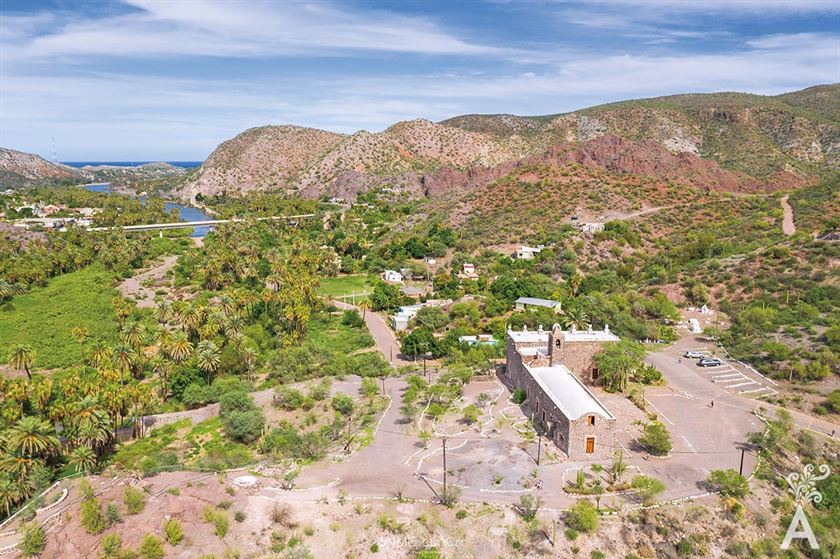The first settlers of this scented land left their mark in rock art, expressing their relationship with the environment. These historical vestiges are undoubtedly of great relevance since they constitute one of the five most important concentrations of rock art in the world. South California rock art is like a magical ideogram of an eminently artistic people that disappeared thousands of years ago but continue to be present through art.
There are many hypotheses about their arrival. However, the work left on the rocks by means of Petro gravure and paintings, reflects the importance their natural state was to these settlers.
Before the discovery by the western world, a legend emerged that motivated the arrival of expeditions to the California peninsula, as it was called in Europe. The legend said it was inhabited by women.
[two_first]The ancient missionaries mention in some of their writings that they had reached a desert land with a very violent population, the latter being something that cost them dearly. The spiritual conquest, as this process of evangelization was truly called, undoubtedly seduced people into thinking it was a grand achievement that required superhuman strength and courage.
[/two_first][two_second]

[/two_second]
The vestiges of the stories are found in the missions scattered throughout the peninsula of Baja California. Especially in Sudcalifornia with the famous missions of San Ignacio, Santa Rosalia de Mulege, Loreto, and San Javier.
The spiritual conquest is largely the result of collective fantasy and literature. It described the mystical characters of this perfumed land and the wild characters that captivated people’s attention.
Literature about the constancy and passion that was in the minds of the first navigators, the myths about cities of abundance, wonderful islands and hidden pathways created a fantastic premonition, anticipating what would later be discovered. They were the first indications of how capable this region is of seduction.
The French oceanographer Jacques Cousteau christened the Gulf of California as the largest aquarium on the planet. He had significant motive for such a declaration; the great wealth of marine diversity. It remains a fundamental attraction for tourists today.
The beauty of the marine fauna and flora have made this sea a prime location for national and international divers. A number of places are available to admire the substantial variety of coral reefs such as Cabo Pulmo near Los Cabos, or the famous Sand Cascades in the Bay of Cabo San Lucas.
One diver, Ramón Bravo, was tirelessly dedicated to protecting the planet’s oceans. As an underwater researcher and cameraman, he was a guide to the contemporary underwater world, always looking for the wonders of the seas, especially the California Sea. Ramón made friends with renowned oceanographer, journalists and fellow cameramen such as the famous Jacques Cousteau, Alberto Friscione, Manuel Lazcano, and Bruno Vailati. He conducted various expeditions to film and publicize the beauties of the scented land through his splendid films.
One of the first adventurers to the peninsula was Ray Cannon, a reporter born in the state of Tennessee in America. He visited in 1947, covering nearly 1,000 miles practically over dirt. At that time, there were only 60 miles of paved roads. It was an amazing journey and he wrote countless articles for the Western Outdoor News. The route that he and many adventurers followed was actually drawn during the missionary era and became known as the Royal Road.
[two_first] Hernán Cortés came ashore in South California on May 3, 1535. Four hundred years later, Abelardo L. Rodríguez Montijo came to the same place where the three crosses were placed. Both were seduced by the extraordinary landscape and the range of colors of the quiet sea. By 1929, the pearl industry in this location had become a thing of the past.[/two_first][two_second]

[/two_second]
Abelardo surely thought that although the pearls were gone, the crosses signified a great treasure.
In 1948, Abelardo L. Rodriguez Montijo and Lucille Bremer turned Las Cruces into a luxury resort and made it their home. Partners and friends followed and built their houses close by, including Robert Fisher, Desi Arnaz, Bing Crosby, Charles Jones, Roger Bacon, John Wayne, and other famous characters of American cinema.
In his poem California Sur, the South California poet Jesus Lopez Gastelum tells us: “… artery of my homeland, capricious silhouette… place of legends, cacti, trees and pirates… land… lavish in salts and foams… mountains… that hide the treasure of its innards … artery of my country, you carry in your flow a human river … ”
Don Salvador Olmos, collaborator and friend of the Rodriguez Bremer family of Hotel Palmilla provided this account. “In 1968, she arrived at the hotel Liz Taylor accompanied by a significant number of her relatives. A stay that was to last three days but spanned 30. On the fourth day, the companions began to leave the hotel, but Miss Taylor stayed. She walked around the hotel, strolled along the beaches, sunbathed, talked with people, visited the kitchen staff in their work… she enjoyed herself fully. She left Hollywood’s life for those days.”
Liz Taylor arrived and did not want to leave. What seduced her? The tranquility, the kindness of the workers, the charisma of the fishermen, the morning sun, the spectacular views.
There are many reasons this scented land, the end of the land, the unknown land, the land of gentleness, the land of the wonderful trees, South California itself, can cast a spell on the visitor. The bonds established by this region and the people keep us thinking we are truly in a magical land.
Complete Issue: http://bit.ly/TravesiaEntreDosMares-T44








